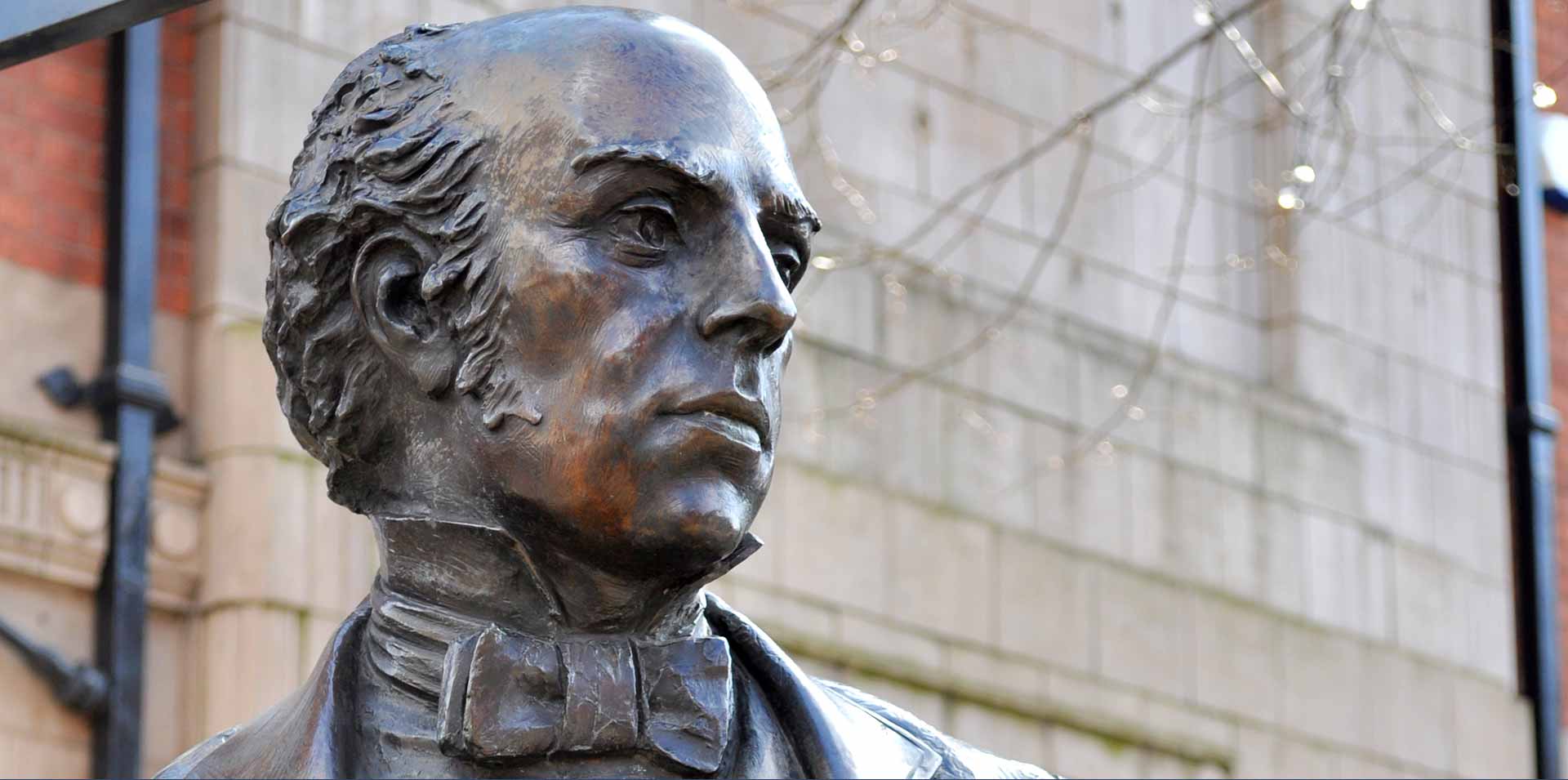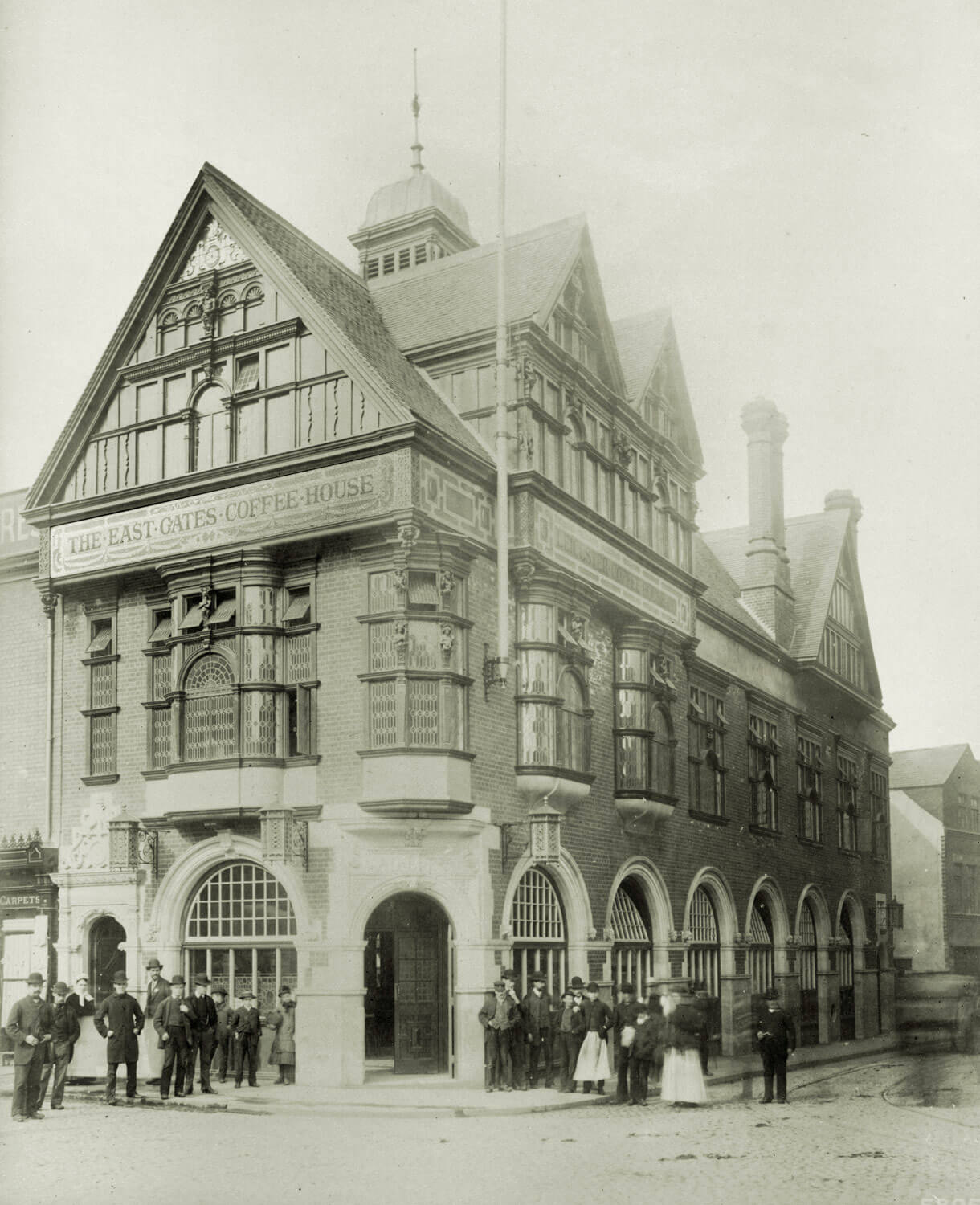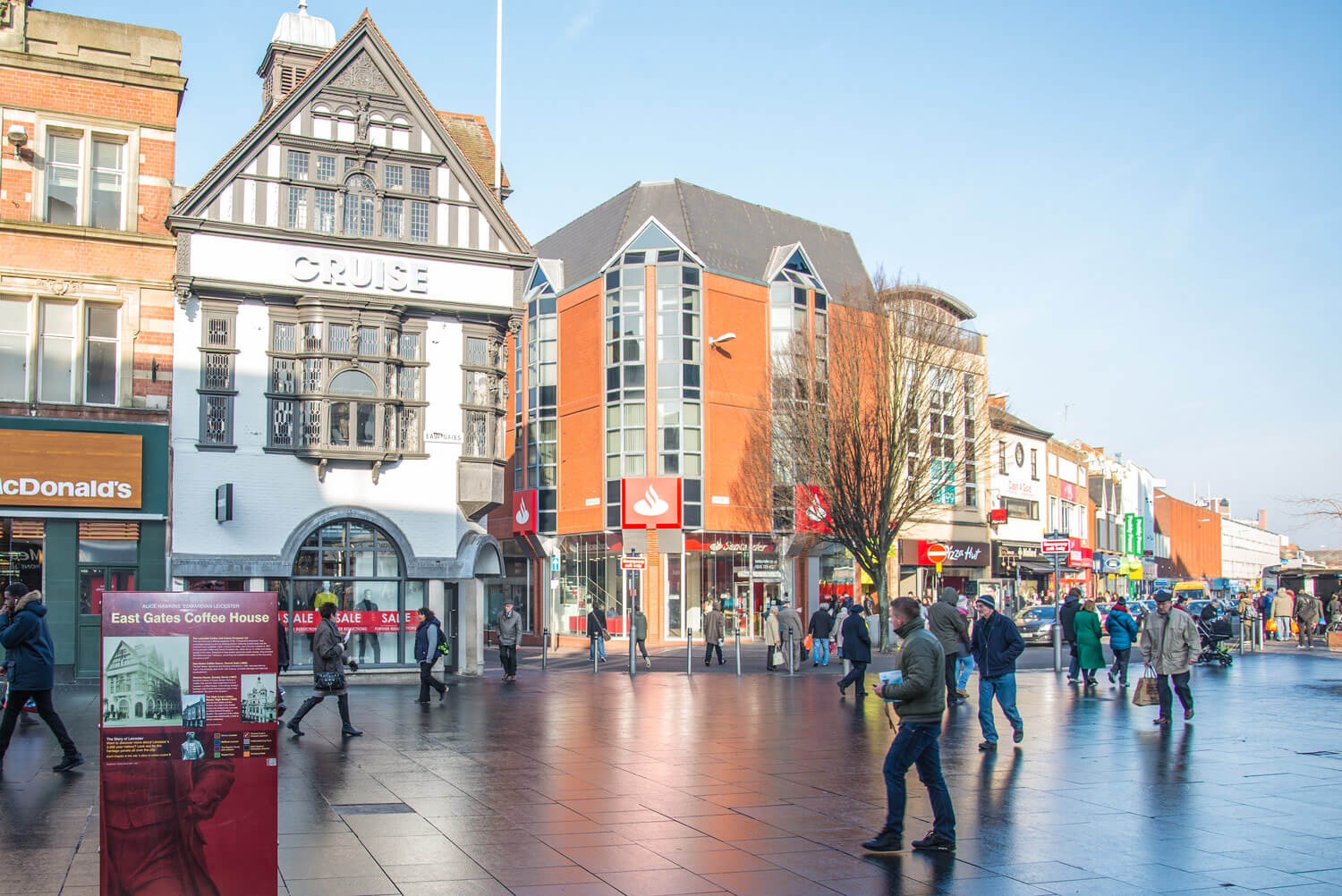The Midland Counties Railway Act (1836) led to the building in 1840 of Leicester’s first mainline railway station, Leicester Campbell Street, on land behind London Road.
- The Victoria Coffee House in Granby Street was said to be “the best in the kingdom”
- Thomas Cook, a supporter of the Temperance Movement, was a founder member of the Leicester Coffee and Cocoa Company Ltd
- Most of the Company’s premises were custom built and designed by the architect Edward Burgess
Thomas Cook and Temperance in Leicester
The Leicester Coffee and Cocoa Company Ltd
Thomas Cook was a lifelong supporter of the Temperance Movement that encouraged people to give up drinking alcohol, believing drunkenness was the cause of many social problems. Cook, a devout Christian, was a founder member in 1877 of the Leicester Coffee and Cocoa Company Ltd., whose aim was to “establish houses, rooms, coffee carts and stalls” around Leicester to provide general refreshment.
Working men’s restaurants
As more working men lived in suburbs on the outskirts of town, there was a need for working men’s restaurants in the town centre. Working men would carry their lunch to work and eat it in a public house as there were few other alternatives available. The coffee houses provided hot and affordable food such as “a large basin of nourishing soup for two pence” and “nutritious, comforting and healthful beverages at the easy price of a penny a pint”. Coffee houses were made even more appealing by the fact they were designed to be bright, attractive and comfortable social spaces where both men and women could go, with newspapers and amusements readily available. Some had a ladies’ room and others a billiards room.
"An extraordinary amount of success"
The coffee houses were praised for their “Size, decoration, fittings, cleanliness and order” surpassing “all that was formerly attainable except at high charges” . The duchess of Rutland, opening the Victoria Coffee House in 1888, praised the directors for combining commercial profit with the benefit of the townspeople , stating she “was constantly receiving letters from various parts of the country asking how it was the coffee houses in Leicester achieved such an extraordinary amount of success” . The company went on to set up 14 coffee houses in the town.

The Coffee Houses
Most of the Company’s premises were custom built and designed by the architect Edward Burgess. The following still remain although today they have alternative uses:
East Gates Coffee House, Church Gate (1885)
The East Gates, opened by the Duchess of Rutland in 1885, was described as “built in the domestic style of the 15th Century and both internally and externally much admired”. The East Gates provided a popular and profitable service for more than 40 years, but sadly closed soon after World War I.
Victoria House, Granby Street (1887)
Named in honour of Queen Golden Victoria´s Jubilee, this was the most magnificent of all of Leicester´s coffee houses. A five-storey turreted building in the French Renaissance style, it was considered “the best in the Kingdom”.
The High Cross Coffee House, High Street (1895)
Like the East Gates and the Victoria, the High Cross Coffee House was designed by Leicester architect Edward Burgess, a Quaker. The exteriors of the coffee houses were deliberately ornate to attract customers.
The end of the Leicester Coffee and Cocoa House movement
Despite a rise in the popularity of tea and coffee drinking and fall in the consumption of alcohol, the coffee houses failed to thrive after World War I and the company was liquidated. Perhaps some of this could be put down to the fact they were not always commercially viable. An account in the Illustrated Leicester Chronicle stated how “many regulars used to come in at midday, bringing their own food, ordering a cup of tea, which I believe was 1/2d., and asking for a plate for their sandwiches”. Another account stated how customers “brought their own food, used the pepper and salt, and never spent a penny – and had a good warm against the stove in winter”.
Gallery


Thomas Cook's Leicester
Roman Leicester
(47- 500) A military fort was erected, attracting traders and a growing civilian community to Leicester (known as Ratae Corieltauvorum to the Romans). The town steadily grew throughout the reign of the Romans.
Medieval Leicester
(500 – 1500) The early years of this period was one of unrest with Saxon, Danes and Norman invaders having their influences over the town. Later, of course, came Richard III and the final battle of the Wars of the Roses was fought on Leicester’s doorstep.
-
The Castle Motte1068

-
Leicester Cathedral1086

-
St Mary de Castro1107

-
Leicester Abbey1138

-
Leicester Castle1150

-
Grey Friars1231

-
The Streets of Medieval Leicester1265

-
Leicester Market1298

-
Trinity Hospital and Chapel1330

-
Bow Bridgecirca 1350

-
Church of the Annunciation1353

-
John O’Gaunt’s Cellar1361

-
St John's Stone1381

-
Leicester Guildhall1390

-
The Magazine1400

-
The Blue Boar Inn1400

-
The High Cross1577

Tudor & Stuart Leicester
(1500 – 1700) The wool trade flourished in Leicester with one local, a former mayor named William Wigston, making his fortune. During the English Civil War a bloody battle was fought as the forces of King Charles I laid siege to the town.
Georgian Leicester
(1700 – 1837) The knitting industry had really stared to take hold and Leicester was fast becoming the main centre of hosiery manufacture in Britain. This new prosperity was reflected throughout the town with broader, paved streets lined with elegant brick buildings and genteel residences.
-
Great Meeting Unitarian Chapel1708

-
The Globe1720

-
17 Friar Lane1759

-
Black Annis and Dane Hills1764

-
Leicester Royal Infirmary1771

-
New Walk1785

-
Freemasons’ Hall1790

-
Gaols in the City1791

-
Friars Mill1794

-
City Rooms1800

-
Development of Highfields1800

-
Wesleyan Chapel1815

-
20 Glebe Street1820

-
Charles Street Baptist Chapel1830

-
Glenfield Tunnel1832

-
James Cook1832

Victorian Leicester
(1837 – 1901) The industrial revolution had a huge effect on Leicester resulting in the population growing from 40,000 to 212,000 during this period. Many of Leicester's most iconic buildings were erected during this time as wealthy Victorians made their mark on the town.
-
Leicester Union Workhouse1839

-
Campbell Street and London Road Railway Stations1840

-
The Vulcan Works1842

-
Belvoir Street Chapel1845

-
Welford Road Cemetery1849

-
Leicester Museum & Art Gallery1849

-
King Street1850

-
Cook’s Temperance Hall & Hotel1853

-
Amos Sherriff1856

-
Weighbridge Toll Collector’s House1860

-
4 Belmont Villas1862

-
Top Hat Terrace1864

-
Corah and Sons - St Margaret's Works1865

-
Kirby & West Dairy1865

-
The Clock Tower1868

-
Wimbledon Works1870

-
The Leicestershire Banking Company1871

-
St Mark’s Church and School1872

-
Victorian Turkish Baths1872

-
The Town Hall1876

-
Central Fire Stations1876

-
Aylestone Road Gas Works and Gas Museum1879

-
Gas Workers Cottages1879

-
Leicestershire County Cricket Club1879

-
Welford Road Tigers Rugby Club1880

-
Secular Hall1881

-
Development of Highfields1800

-
Abbey Park1881

-
Abbey Park Buildings1881

-
Victoria Park and Lutyens War Memorial1883

-
Leicester Fosse FC 18841884

-
Leicester Coffee and Cocoa Company Coffee Houses1885

-
St Barnabas Church and Vicarage1886

-
Abbey Pumping Station1891

-
Luke Turner & Co. Ltd.1893

-
West Bridge Station1893

-
Thomas Cook Building1894

-
The White House1896

-
Alexandra House1897

-
Leicester Boys Club1897

-
Grand Hotel and General Newsroom1898

-
Highfield Street Synagogue1898

-
Western Park1899

-
Asfordby Street Police Station1899

-
Leicester Central Railway Station1899

Edwardian Leicester
(1901 – 1910) Electric trams came to the streets of Leicester and increased literacy among the citizens led to many becoming politicised. The famous 1905 ‘March of the Unemployed to London’ left from Leicester market when 30,000 people came to witness the historic event.
-
YMCA Building1900

-
The Palace Theatre1901

-
Pares's Bank1901

-
Coronation Buildings1902

-
Halfords1902

-
High Street1904

-
George Biddles and Leicester's Boxing Heritage1904

-
Municipal Library1905

-
Leicester Boys Club1897

-
The Marquis Wellington1907

-
Guild Hall Colton Street1909

-
Women's Social and Political Union Shop1910

-
Turkey Café1901

Early 20th Century Leicester
(1910 – 1973) The diverse industrial base meant Leicester was able to cope with the economic challenges of the 1920s and 1930s. New light engineering businesses, such as typewriter and scientific instrument making, complemented the more traditional industries of hosiery and footwear manufacturing.
-
Dryad Handicrafts1912

-
De Montfort Hall1913

-
Leicester During the First World War1914

-
Fox’s Glacier Mints1918

-
Statue of Liberty1919

-
Housing in Saffron Lane1924

-
Winstanley House1925

-
Housing in North Braunstone1926

-
Lancaster Road Fire Station1927

-
The Little Theatre1930

-
Saffron Hill Cemetery1931

-
Braunstone Hall Junior School1932

-
Former City Police Headquarters1933

-
Savoy Cinema1937

-
Eliane Sophie Plewman1937
-
City Hall1938

-
Athena - The Odeon Cinema1938

-
The Blitz in Highfields1940

-
Freeman, Hardy and Willis - Leicester Blitz1940

-
Leicester Airport1942

-
Leicester’s Windrush Generations1948

-
Netherhall Estate1950
-
Housing at Eyres Monsell1951

-
Silver Street and The Lanes1960

-
Bostik1960

-
Auto-Magic Car Park (Lee Circle)1961

-
University of Leicester Engineering Building1963

-
Sue Townsend Theatre1963

-
Central Mosque1968

-
Belgrave Flyover1973

Modern Leicester
(1973 – present day) Industry was still thriving in the city during the 1970s, with the work opportunities attracting many immigrants from all over the world. While industry has declined in recent years, excellent transport links have made Leicester an attractive centre for many businesses. The City now has much to be proud of including its sporting achievements and the richness of its cultural heritage and diversity.
-
Haymarket Theatre1973

-
The Golden Mile1974

-
Acting Up Against AIDS1976

-
Belgrave Neighbourhood Centre1977

-
Diwali in Leicester1983

-
Leicester Caribbean Carnival1985

-
Samworth Brothers1986

-
Jain Centre1988

-
Guru Nanak Dev Ji Gurdwara1989

-
King Power Stadium2002

-
LCB Depot2004

-
Curve2008

-
BAPS Shri Swaminarayan Mandir2011

-
Makers Yard2012

- Roman Leicester
- Medieval Leicester
- Tudor & Stuart Leicester
- Georgian Leicester
- Victorian Leicester
- Edwardian Leicester
- Early 20th Century Leicester
- Modern Leicester















































































































































